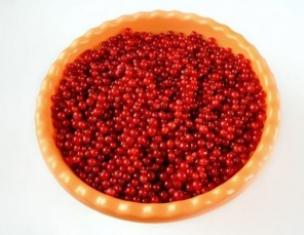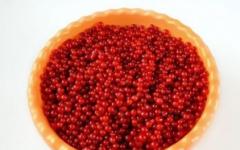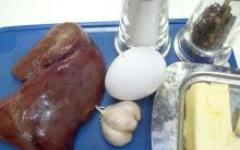On 100 g product accounts for:
Sea buckthorn is a healing berry in our city. It contains a huge amount of vitamins, microelements, and organic acids. Sea buckthorn berries help against many diseases, but they are also taken for prevention.
What is contained in sea buckthorn fruits? They contain not only sugar and malic, tartaric and oxalic acids, but also vitamins in large quantities: C, B1, B2, folic acid, PP, K, P and E, carotene and carotenoids, as well as a lot of rutin, iron, boron, manganese. And even fatty acids - oleic and linoleic - are present in sea buckthorn.
For normal functioning of the nervous system, it is necessary to consume serotonin, which can be found in the bark of sea buckthorn branches and the fruits themselves. And even sea buckthorn leaves contain vitamins - ascorbic acid, phytoncils, tannins and microelements.
The well-known sea buckthorn oil is obtained from red-fruited varieties of sea buckthorn. It is used very widely in medicine - it is used externally and internally. The beneficial properties of sea buckthorn oil are unique: it is bactericidal, promotes tissue epithelization, heals wounds and damage to mucous membranes, and soothes pain.
You can squeeze juice out of sea buckthorn - not only is it very tasty, but it will also help with coughs if mixed with honey. In particular, to prevent diseases of the upper respiratory tract, it is necessary to inhale with sea buckthorn oil. But if you have chronic laryngitis or pharyngitis, you need to lubricate the mucous membrane with sea buckthorn oil, which is moistened with a cotton swab.
Oil is also used to lubricate the surgical wound after removal of the tonsils - this promotes better healing and prevents an increase in body temperature. Sea buckthorn oil is also used in the form of drops - for sinusitis, 4-5 drops in each sinus.
Sea buckthorn fruits are often collected and stored in the refrigerator. In winter they are a storehouse of vitamins. It is enough to take out a handful of sea buckthorn berries every day and pour boiling water over them to be provided with all the necessary vitamins.
Patients with toxic hepatitis are often prescribed berries and sea buckthorn juice as an addition to complex therapy. Sea buckthorn berries have a strong effect on intestinal motility, and a decoction of sea buckthorn seeds is an excellent laxative.
For those who have stomach problems, a decoction of sea buckthorn berries will help: boil 3 tablespoons and 0.5 liters of hot water for 10 minutes, strain. Drink two to three glasses of tea a day for stomach and duodenal ulcers.
Of course, sea buckthorn is used very actively in folk medicine. First of all, for allergic skin diseases such as dermatitis and eczema, as well as for ulcers and radiation dermatitis. To cope with these diseases, you need to prepare a decoction at the rate of 20 g of berries per 1 glass of water. Boil for 15 minutes, leave for 30 minutes, strain and drink 100 g throughout the day. Or you can simply take baths with an infusion of sea buckthorn branches and leaves.
Calories, kcal:
Proteins, g:
Carbohydrates, g:
Sea buckthorn (lat. Hippophaë) is usually called a plant belonging to the family Suckers and its fruits. Typically, sea buckthorn is a bush or tree, 2 to 4 meters tall, with narrow olive-colored leaves, long spines and distinctive clusters of bright orange berries. The berries have a short stalk, so it seems that they are located directly on the branches, clinging to them (apparently, this feature became the reason for the Russian name for the berries). Sea buckthorn berries are yellow-orange or orange-red, small in size, round or oval (calorizator). Under the fairly dense skin there is an elastic, slightly oily juicy pulp with a pleasant sweet and sour taste and a unique aroma.
Calorie content of sea buckthorn
The calorie content of sea buckthorn is 82 kcal per 100 grams of product.
Sea buckthorn has a truly unique vitamin and mineral complex, which contains: , vitamins , and , as well as almost the entire periodic table: , and , and , boron and , and titanium, silicon, and aluminum, and . The berry is rich in fiber, organic acids, phytoncides, and contains betaine and tannins. Due to the presence of useful substances, the berry is a natural multivitamin.
Sea buckthorn berries are a natural antibiotic, have anti-inflammatory and bactericidal properties, are used for colds and viral diseases, and are considered an excellent immunostimulant. Sea buckthorn has wound-healing properties, accelerating granulation and epithelization of damaged tissues. made from sea buckthorn berries is widely used in folk and traditional medicine; it perfectly treats any cracks and ulcers, both on the skin and internal organs (the oil is used to treat cervical erosion, hemorrhoids), and baldness. Sea buckthorn oil is used by dentists and ophthalmologists; it is often used in the treatment of cancer.

Harm from sea buckthorn
Sea buckthorn is an allergen, so caution should be given to young children and people prone to allergic reactions. Contraindications to the use of sea buckthorn are the presence of cholecystitis, urolithiasis, pancreatitis and liver disease.
Harvesting is a pleasant and troublesome task; sea buckthorn should be collected in dry weather, after the berries are fully ripe. If the fruits are easily removed one by one, then you can carefully collect the berries (calorizer). If the berries come off, leaving part of the peel on the stalks and thereby losing juice, then it is better to cut off the branches strewn with berries, especially those that bend towards the ground from the abundance of fruits. The harvested crop should be sorted; if the berries were not planned to be processed, they can be preserved by putting them in the freezer or air drying. Before freezing, you do not need to wash the berries; you should pack them so that there is a minimum of air inside the bag.

Sea buckthorn varieties
The presence of thorns complicates the picking of berries, so the appearance of varieties with fewer thorns or without them pleases gardeners and gardeners. The most common varieties of sea buckthorn are: Podruga, Obilnaya, Nugget, Giant, Gift of Katuni, Lyubimaya, Moscow Pineapple, Etna, Zlata, Perchik, Amber. When choosing seedlings for planting, you need to take into account the winter hardiness of a particular species.
Sea buckthorn in cooking
The most common delicacy is fresh sea buckthorn, pureed with sugar, but the product must be stored in the refrigerator. Sea buckthorn is used to make jam and confiture, and to make filling for pies. The berries are used to make liqueurs and tinctures, liqueurs and tea. - a tasty and healthy drink, has a mild laxative property.
For more information about sea buckthorn and its benefits, see the video clip of the TV show “About the Most Important Thing.”
Especially for
Copying this article in whole or in part is prohibited.
In Ancient Greece, sea buckthorn was called the “shiny horse,” since it was noticed that horses that grazed near the thickets of this thorny bush, ate its ripe berries and leaves, became more plump, and their skin and mane simply shone. At first, sea buckthorn was used as a medicine for exhausted and sick horses. Afterwards, sea buckthorn was given to people, mainly for the treatment of athletes and warriors.
Mention of the wonderful properties of sea buckthorn can be found in ancient Tibetan manuscripts, as well as in ancient Chinese medical books. All available descriptions boil down to the fact that sea buckthorn is a universal remedy. During the dark Middle Ages, sea buckthorn was forgotten.
In Russia, scientists from the St. Petersburg Botanical Garden were the first to grow sea buckthorn only at the beginning of the 19th century, but the first varietal sea buckthorn appeared a century later - in the early 30s of the 20th century. Its place of growth was Altai. We can say that the heyday of the use and cultivation of sea buckthorn occurred in the 80s of the 20th century, when doctors drew attention to a whole range of beneficial properties of sea buckthorn oil. It turned out that in many cases its effect could only be compared to a miracle. Sea buckthorn oil was not readily available. To purchase it, it was necessary to obtain a prescription on a special form, and the oil itself became a scarce commodity.
Today, the noise around sea buckthorn has died down a little, and quite in vain. Sea buckthorn is not only a valuable source of vitamins, minerals and other useful substances. In addition, it is also a delicious bright orange berry.
Sea buckthorn is one of the oldest plants used by humans. Sea buckthorn loves light and light, moist soil, so in the wild it most often grows along river banks. The plant received its Russian name because of the berries that cling to the branches of the bush in bright orange clusters. Sea buckthorn is most widespread in Siberia, where it is called the “Siberian pineapple” for its inherent subtle aroma, reminiscent of a sweet tropical fruit.
Calorie content of sea buckthorn and vitamins
Calorie and protein content in 100 g of sea buckthorn
- proteins 1.2 g
- carbohydrates 5.7 g
- fat 5.4 g
- water 83 g
- energy (kcal) 82 kcal
Vitamins in sea buckthorn
- Vitamin PP 0.4 g
- Beta-carotene 1.5 g
- Vitamin A (VE) 250 g
- Vitamin C (ascorbic acid) 200 g
- Vitamin H (biotin) 3.3 g
- Vitamin B1 (thiamine) 0.03 g
- Vitamin B2 (riboflavin) 0.05 g
- Vitamin B5 (pantothenic acid) 0.2 g
- Vitamin B6 (pyridoxine) 0.8 g
- Vitamin B9 (folate) 9 g
- Vitamin E (TE) 5 g
- iron (Fe) 1.4 g
- calcium (Ca) 22 g
- potassium (K) 193 g
- magnesium (Mg) 30 g
- phosphorus (P) 9 g
- sodium (Na) 4 g
Health benefits of sea buckthorn
When talking about the benefits of sea buckthorn, one cannot fail to mention the special substances it contains that make it so beneficial for health. In addition to the usual vitamins and minerals, sea buckthorn contains many biologically active substances that allow it to be used as a therapeutic or prophylactic agent. Particularly valuable is sea buckthorn oil, as well as its constituent alkaloids, sterols, organic acids, trace elements, flavonoids, pectin substances, etc. All this together makes sea buckthorn a real storehouse of substances that are most valuable for human health. Just 100 grams of fresh sea buckthorn berries or juice will provide you with your daily requirement of almost all substances beneficial to the body.
Both folk and traditional medicine use sea buckthorn as a therapeutic or prophylactic agent for many diseases. These are vitamin deficiency, bedsores, wounds, burns, radiation damage to the mucous membranes or skin, gastric ulcers, erosions, skin diseases, diseases of the nervous system and cardiovascular. Of course, this is not a complete list, but it is enough to understand that sea buckthorn has not earned the title “Orange Queen” for nothing.
Sea buckthorn has also found considerable use in cooking. Its berries are used to make preserves, jams, syrups, jellies, juices, marmalade, compotes, marmalade, marshmallows, tinctures, wine and liqueurs. Sea buckthorn is good in any form.
However, despite all its beneficial properties, sea buckthorn has a number of contraindications. First of all, it should not be used by people suffering from high acidity, gastritis, cholecystitis and cholelithiasis.
A low thorny tree or shrub, sea buckthorn is found in the wild on the banks of reservoirs, near rivers, streams, and on pebble and sandy soils.
Due to its beneficial properties, sea buckthorn is widely used not only as a vitamin supplement, but also for the treatment of many diseases.
The most valuable things about sea buckthorn are its fruits, leaves, and bark.
The berries are bright orange, elongated or spherical in shape, densely located on the branch.
Sea buckthorn: composition, calorie content, use of the plant
Sea buckthorn fruits are beneficial for their rich content of sugar, organic acids, and vitamins (C, B, PP, K, P, E). Sea buckthorn contains a lot of carotene, flavonoids, tannins and nitrogenous substances, fatty acids, and phytoncides.
The plant is a real storehouse of minerals and trace elements. It contains iron, boron, manganese, etc.
Calorie content sea buckthorn is not too high and is 82 kcal per 100 g product.
1. Sea buckthorn oil- a product with many useful properties. It is used for skin lesions, gastritis, ulcers, and women's diseases.
Sea buckthorn oil has gained popularity due to its anti-inflammatory, epithelializing, bactericidal, and analgesic properties.
It is used in the treatment of bedsores, frostbite, burns, trophic ulcers, radiation injuries, cracks and wounds.
Sea buckthorn oil is effective in treating cervical erosion. In this case, a tampon soaked in a healing composition is inserted into the vagina for 1-2 weeks and left overnight.
The oil is also effective for gout. The recipe for preparing the remedy is as follows: First, the oil (100 g) is brought to a boil and alcohol (100 ml) is added to it. The mixture is boiled over very low heat for about 15 minutes, after which it is cooled and used to lubricate sore spots. The procedure is performed until the pain subsides.
The product is used for the treatment of sinusitis by injecting 4-5 ml of sterile oil into the maxillary sinus.
Sea buckthorn oil is widely used in surgery for the treatment of sutures, abscesses, ulcers, boils.
Using the product you can improve the condition of the skin, make it soft, elastic, and moisturized. It is not without reason that sea buckthorn oil is included in many cosmetic products: creams, lotions, shampoos, toothpastes.
2. Not only sea buckthorn oil has beneficial properties, but also the leaves. Infusion of crushed leaves plants are used for joint diseases. 1 tablespoon of raw material is poured with boiling water and boiled for 10 minutes. Then the composition is cooled, filtered, water is added to it (to restore the original volume) and drunk 2 times a day, half a glass.
3. Sea buckthorn has been successfully used in cosmetology. A decoction of the same leaves is used to rinse hair after washing.
And get rid of for acne and large pores you can use compresses, which are prepared like this: put a sea buckthorn leaf and chamomile flowers in a gauze bag. Then keep it in boiling water for 3-5 minutes, cool and apply to problem areas. Cover the face with a towel.
The duration of the procedure is 10-15 minutes. Finally, you can wipe your skin with an ice cube.
4. Sea buckthorn leaf is beneficial for the body for skin diseases. As an additional remedy for the treatment of psoriasis and neurodermatitis, baths are used, where, in addition to sea buckthorn leaves, there are: chamomile flowers, knotweed grass, viburnum branches, and horsetail.
The prepared composition is placed in a cotton bag and placed under running water. Hold until the bath is completely filled.
5. To strengthen the body’s defenses, use decoction of sea buckthorn and rosehip fruits(1 glass each), calendula flowers(100 g). The composition is poured with hot water (3 glasses), wrapped and left for 12 hours. After this, drink the healing potion 1 glass per day.
6. The beneficial properties of sea buckthorn make it possible to use it for conjunctivitis. In case of illness, instill eye drops (1-2 drops) with sterilized juice of the plant’s fruits 2-3 times a day.
7. Sea buckthorn is indispensable as a voice restorative. The disease can be cured using the following composition: first, the berries (0.5 cups) are poured with water and brought to a boil. Cook for 20 minutes. The cooled broth is filtered, honey (150 g) and cognac or vodka (1 tablespoon) are added.
The mixture is allowed to brew for about an hour. Then drink the solution a couple of sips every hour.
8. Sea buckthorn is beneficial to cleanse the body. It is used as a composition that is easy to prepare yourself. It is necessary to melt honey (2 cups) in a water bath, then add sea buckthorn juice (2 cups) to it and simmer the mixture over low heat.
When it has cooled, you need to throw in the yeast (2 large spoons) and leave the mixture in a warm place to infuse. After this, the composition is poured into a clean container, closed and allowed to stand for a month.
Drink a healing remedy based on sea buckthorn, 1 spoon in the morning and evening hours after meals.
9. For joint pain, use hot compresses from sea buckthorn berries. To begin with, fresh fruits are steamed, then laid out on a cotton cloth and placed on sore spots.
10. The fruits of the plant are widely used in cooking. Juices, mousses, decoctions, tea, compotes, jam, preserves are prepared from them.
Sea buckthorn: what are the benefits for the body?
Due to its rich composition, sea buckthorn is extremely beneficial for human health.
2. Sea buckthorn oil, which is prepared from healing berries, is famous for its bactericidal properties. It copes well with various skin lesions, wounds, and burns.
The oil is used as a means of improving lipid metabolism and increasing protein content in the liver. Sea buckthorn oil is also useful for restoration processes in damaged tissues.
3. Sea buckthorn berries are a 100% natural concentrated vitamin product. An infusion of berries is used for a lack of vitamins and general weakness.
4. Sea buckthorn fruits are good for health due to their anti-sclerotic effect. It’s not for nothing that sea buckthorn is so loved by older people.
5. Juice from sea buckthorn berries is an excellent antitussive remedy.
6. Sea buckthorn is useful for the body with digestive problems. A decoction of the seeds of the plant helps with constipation.
7. Sea buckthorn is rich in vitamin B. Therefore, it is often used to improve potency.
8. The plant (its fruits and leaves) is capable of removing uric and oxalic acids from the body, which are one of the causes of joint pain.
Sea buckthorn: what is harmful to health?
Sea buckthorn is extremely beneficial for human health. But due to improper use, it, like any medicinal plant, can cause harm.
Sea buckthorn oil should not be consumed in the following cases:
Acute form of cholecystitis, hepatitis
Pancreatic diseases
Tendency to diarrhea
Healing berries are contraindicated for diseases of the pancreas, gall, liver (in acute form), as well as for gastrointestinal disorders.
Those who suffer from stomach and duodenal ulcers are allowed sea buckthorn oil, but not berries or juice.
For pregnant and nursing mothers: the benefits and harms of sea buckthorn
As is known, pregnant women are most susceptible to viral infections due to reduced immunity. Drinking a small amount of sea buckthorn juice every day can strengthen the body's defenses.
In case of a cold, expectant mothers can safely use sea buckthorn oil externally to lubricate the nose and throat. Rinsing with a mixture of 1 teaspoon of oil and a glass of warm water is also useful.
Dry, pressed cough familiar to many women expecting a child. It is dangerous because it causes contraction of the uterus, and this, in turn, is fraught with undesirable consequences.
Sea buckthorn is beneficial for the health of pregnant women as a mild laxative. The seeds of the plant are used to treat constipation.
Sea buckthorn is irreplaceable and for heartburn. A mixture of a small spoon of oil and a pinch of soda relieves burning sensation in the esophagus and stomach for a long time.
As for nursing mothers, sea buckthorn oil is a real salvation for them from cracked nipples. In addition, sea buckthorn tea is recommended for nursing mothers to improve lactation.
Contraindications for pregnant and lactating women regarding the use of sea buckthorn are the same as for everyone.
Sea buckthorn for children: good or bad?
Sea buckthorn is incredibly beneficial for children's bodies. It can compensate for the lack of vitamins and microelements and strengthen the defenses.
Fruit drinks, syrups, and juice are made from “miracle berries.” Vitamin products are not only healthy, but also extremely tasty.
Sea buckthorn, like any new product, must be given to young children carefully, observing the reaction. You can start taking it with 1-2 berries.
The fruits of the plant can diversify a child’s menu and make it as healthy as possible.
However, sea buckthorn is contraindicated for children who have increased gastric acidity or liver and gall bladder diseases.
The familiar, beloved orange berry is really good for health. The rich vitamin composition of sea buckthorn, low calorie content, and good taste make the product indispensable for the treatment and prevention of many diseases.
src=»https://polzavred.ru/data:image/gif;base64,R0lGODdhAQABAPAAAP///wAAACwAAAAAAQABAEACAkQBADs=» data-lazy-src=»https://polzavred.ru/wp-content/uploads/poleznye-svojstva -oblepihi-logo.jpg" class="attachment-post-thumbnail size-post-thumbnail wp-post-image" alt="Sea buckthorn - beneficial and medicinal properties"
The benefits of sea buckthorn are known to many - the berries are used as a medicine and a cosmetology product.
Sea buckthorn is a shrub that belongs to the Lokhov family, growing in the mountainous and coastal regions of Asia and Europe. Its botanical name, Hippophae rhamnoides, means "the tree that makes the horse shine." Mention of it is found in the chronicles of Genghis Khan: sea buckthorn leaves were given to horses and their fur became shiny and silky.
It is believed that sea buckthorn originated from the Himalayas. It was also used by the ancient Greeks and other Europeans. The berry appears in ancient Tibetan texts and is mentioned in Indian medicine, early Chinese formularies and ancient Greek mythology.
Sea buckthorn has a long history of use in folk medicine, dating back thousands of years. Tibetan doctors during the Tang Dynasty used the medicinal properties of sea buckthorn to relieve health problems. The berry has been known in Ayurvedic medicine since 5000 BC. e. 1
Modern man began to use the beneficial properties of sea buckthorn at the end of the 20th century. Biologically active substances are present in all parts of sea buckthorn, and they are used as raw materials for health foods and nutritional supplements. The oil, berries, leaves and bark have medicinal properties. They are used to produce juice, jam, jellies and sweets, as well as alcoholic and non-alcoholic drinks.
Sea buckthorn berry is becoming as popular as pomegranate and acai berry due to its impressive composition. It contains more than 190 nutrients, many vitamins, minerals, fiber and protein:
- Polyunsaturated fatty acids . This is the only plant that is a source of omega 3, 6, 7 and 9. There is a big difference between the fatty acid composition of the two types of sea buckthorn oils. The main fatty acids in kernel oil are omega 3 and 6, linoleic acid and alpha-linoleic acid - about 70%. The oil contains monounsaturated fatty acids and omega-7 - palmitoleic and palmitic acids. 2
- Vitamins. Ascorbic acid in berries – 400 mg/100 g. This is 4 times more than in oranges. Contains vitamins B1, B2, B6 and E, which is as much as in wheat germ. They are powerful antioxidants and bind free radicals. 3
- Carotenoids . The total amount in fruits ranges from 8.85-25.51 mg/100 g. 4Sea buckthorn has 3 times more vitamin A than carrots.
- Flavonoids – isorhamnetin, kaempferol and quercetin. They have anti-cancer and general strengthening effects.
- Proteins . Sea buckthorn fruits contain superoxide dismutase (SOD), an important enzyme that helps bind free radicals. There is 4 times more of it than in ginseng.
Sea buckthorn seeds and oil are rich in nutrients - tocotrienols and tocopherols, terpenes and glucosides, plant sterols and trace elements: iron, selenium and manganese. 5 Despite the high content of fatty acids, sea buckthorn does not have many calories - only 82 kcal per 100 g.
The rich composition of sea buckthorn determines its beneficial properties, so sea buckthorn is used in medicine, food and cosmetic industries for the beauty of hair and skin. Using sea buckthorn oil daily helps slow down the signs of aging by nourishing the body's integumentary and connective tissues.
For joints
The anti-inflammatory effect of sea buckthorn oil has found application in the treatment of arthrosis and arthritis. It is used both when taken orally and in the form of compresses and ointments. 6
For the heart and blood vessels
Sea buckthorn berries are known for their cholesterol-busting properties. The antioxidants in berries prevent the “bad” oxidation of cholesterol, where it sticks to the inner walls of blood vessels and causes them to narrow. Eating berries fresh or in drinks will prevent clogged arteries, lower blood pressure and reduce the risk of cardiovascular disease. 7
For vision
For the lungs
The antibacterial effect of sea buckthorn is used in the treatment of colds and viral diseases of the respiratory tract. It is used in the form of decoctions, taking sea buckthorn oil orally or lubricating the nasal mucosa. 9
For the stomach and liver
It has antiulcer properties, increases the hydrophobicity of the stomach and smooth digestion of food due to the procyanidins and polyphenols contained in the seed oil. 10 A decoction of fresh sea buckthorn berries is a remedy for constipation.
According to Indian scientists, the leaves are rich in antioxidants and can help prevent liver disease if consumed as tea. 11
For diabetics
Adding sea buckthorn to food causes a decrease in body weight and blood glucose levels in diabetic patients. 12
For women
Sea buckthorn in gynecology is used in the form of tampons with oil to treat cervical erosions and inflammation of the vaginal walls.
For skin
The healing and rejuvenating effect of sea buckthorn oil on the skin is due to the content of fatty acids and vitamins A and E. When used topically, it is a natural cleanser and exfoliant. It helps treat burns, cuts, wounds, sunburn, rashes and other types of skin damage. Decoctions of the leaves make hair beautiful and shiny. 13 Nursing mothers apply sea buckthorn oil to their babies' cracked nipples and gums when they start teething.
For immunity
Sea buckthorn oil's unique content of high fatty acids and richness of nutrients make it one of the healthiest vegetable oils. It has high antioxidant, anti-inflammatory and antiviral properties that improve the overall health of the body and strengthen the immune system. 14
Sea buckthorn for pregnant women
During pregnancy, this is one of the most useful products. If you eat several berries a day, you will get a set of essential vitamins, microelements and antioxidants. Sea buckthorn oil helps prevent stretch marks on the skin and is a mild laxative. This product is practically hypoallergenic for the expectant mother and her baby.
Medicinal properties and uses of sea buckthorn
The anti-inflammatory and immunomodulatory properties of sea buckthorn have found application in cosmetology as a remedy for inflammation and dry skin. It is used to lubricate wounds and affected areas of the skin. Apply to the nasal area for runny nose and colds; the leaves are used to make a gargle. It is also used for coughs.
Sea buckthorn in gynecology is used in the form of tampons with oil to treat cervical erosions and inflammation of the vaginal walls.









